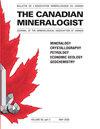证明一个优势端元公式总是可以被写用于矿物或晶体结构
IF 1.5
4区 地球科学
Q3 MINERALOGY
引用次数: 5
摘要
端元公式必须是:(1)与矿物的晶体结构一致,(2)电子中性(即不携带净电荷),和(3)不可约[即不能被分解为与原始公式具有相同键拓扑结构(原子排列)的组分]。端元公式的化学计量必须与结构中位点的“化学计量”相匹配;为了便于表达,我在这里把这样一个公式表示为化学端基。为了使化学端基成为真正的端基,相应的结构必须服从键价理论的价和规则。对于大多数矿物,化学端基和(真正的)端基是相同的。然而,在局部有序会导致某些局部排列强烈偏离价和规则的情况下,这种排列不可能发生,并且(真实)端基与化学端基不同。我提出了启发式和代数证明,证明了一个特定的化学公式总是可以用一个相应的主导端元公式来表示。可以通过计算所考虑的矿物配方与所有可能的端部构件组成之间的差异来得出该主要端部构件;最接近所考虑的矿物配方的端部构件配方是主导端部构件。本文章由计算机程序翻译,如有差异,请以英文原文为准。
Proof That a Dominant Endmember Formula Can Always Be Written for a Mineral or a Crystal Structure
An endmember formula must be: (1) conformable with the crystal structure of the mineral, (2) electroneutral (i.e., not carry a net electric charge), and (3) irreducible [i.e., not capable of being factored into components that have the same bond topology (atomic arrangement) as that of the original formula]. The stoichiometry of an endmember formula must match the “stoichiometry” of the sites in the structure; for ease of expression, I denote such a formula here as a chemical endmember. In order for a chemical endmember to be a true endmember, the corresponding structure must obey the valence-sum rule of bond-valence theory. For most minerals, the chemical endmember and the (true) endmember are the same. However, where local order would lead to strong deviation from the valence-sum rule for some local arrangements, such arrangements cannot occur and the (true) endmember differs from the chemical endmember. I present heuristic and algebraic proofs that a specific chemical formula can always be represented by a corresponding dominant endmember formula. That dominant endmember may be derived by calculating the difference between the mineral formula considered and all of the possible endmember compositions; the endmember formula which is closest to the mineral formula considered is the dominant endmember.
求助全文
通过发布文献求助,成功后即可免费获取论文全文。
去求助
来源期刊

Canadian Mineralogist
地学-矿物学
CiteScore
2.20
自引率
22.20%
发文量
45
审稿时长
4-8 weeks
期刊介绍:
Since 1962, The Canadian Mineralogist has published papers dealing with all aspects of mineralogy, crystallography, petrology, economic geology, geochemistry, and applied mineralogy.
 求助内容:
求助内容: 应助结果提醒方式:
应助结果提醒方式:


